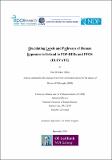| dc.description.abstract | BFRs such as hexabromocyclododecane (HBCDD) and polybrominated diphenyl ethers (PBDEs) were used as flame retardants (FRs) in soft furnishings, building insulation foams, electronic and electrical goods. Perfluoroalkyl substances (PFASs) have been used as a water and stain repellent in apparel and textiles such as carpets and in firefighting foams. PBDEs, HBCDDs and some PFASs are listed as POPs under the Stockholm Convention leading to increased demand for replacement FRs such as decabromodiphenyl ethane (DBDPE). To fully characterise human exposure to these contaminants, an Irish human bio-monitoring (HBM) study, coupled with environmental surveys of indoor air, dust and drinking water in Irish microenvironments, has been completed.
Indoor air and dust samples collected from Irish homes, cars, offices and schools were collected and analysed for PBDEs, DBDPE, HBCDD and PFASs (n=30 per microenvironment category). Drinking water samples collected from homes, offices (n=85) and retail outlets (n=31) were analysed for PFASs. The same contaminants were measured in 16 pooled samples of human milk collected from 92 Irish primiparas attending two Irish hospitals.
DBDPE concentrations in indoor air and dust exceed concentrations reported in previous international studies. Non-dietary sources for PBDEs, HBCDDs and PFASs are within current EFSA or USEPA comparison guidelines, where available. Modelled adult exposures for PFOA exceeded provisional EFSA TWI in high exposure scenarios.
Human bioburdens of congeners associated with the use of HBCDDs and Penta- and Octa-BDEs are significantly lower (p<0.05) than those reported in the last Irish HBM study, suggesting that legislative restrictions for these chemicals have had a positive impact on human exposure; however concentrations of a replacement FR (DBDPE) are now present at a higher detection frequency, consistent with results from the environmental surveys. Further studies on the health implications of DBDPE exposure, and studies of dietary and dermal exposure to BFRs and PFASs are now required. | en_IE |


